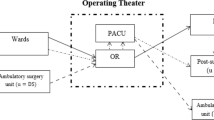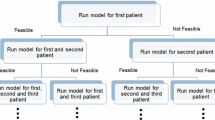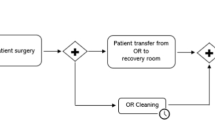Abstract
This paper considers the problem of building a schedule of elective surgery patients for a unit of a hospital. Two phases are followed. In the first phase, a tentative schedule is calculated 2 weeks before the planning period looking to minimise the percentage of tardy patients. Several weight-based short-term objective functions are defined and compared to optimise this goal in the long term. In the second phase, a second and final schedule is made a few days before the planning period, taking into account the changes in the available information. We propose a general methodology to calculate this final schedule. Several strategies to manage the types and importance of changes from the tentative schedule are presented considering the idiosyncrasy of dealing with elective patients. The computational experiments have been carried out via simulation on instances randomly generated according to the data from a Spanish hospital.

Similar content being viewed by others
Explore related subjects
Discover the latest articles and news from researchers in related subjects, suggested using machine learning.References
Addis, B., Carello, G., Grosso, A., & Tànfani, E. (2016). Operating room scheduling and rescheduling: a rolling horizon approach. Flexible Services and Manufacturing Journal, 28(1), 206–232.
Agnetis, A., Coppi, A., Corsini, M., Dellino, G., Meloni, C., & Pranzo, M. (2012). Long term evaluation of operating theatre planning policies. Operations Research for Health Care, 1, 95–104.
Cardoen, B., Demeulemeester, E., & Belien, J. (2010). Operating room planning and scheduling: A literature review. European Journal of Operational Research, 201, 921–932.
Conforti, D., Guerriero, F., Guido, R., & Veltri, M. (2011). An optimal decision-making approach for the management of radiotherapy patients. OR Spectrum, 33, 123–148.
Conway, R., Maxwell, W., & Miller, L. (1967). Theory of scheduling. Reading, MA: Addison-Wesley.
Demeulemeester, E., Beliën, J., Cardoen, B., & Samudra, M. (2013). Operating Room Planning and Scheduling, Chapter 5 (pp. 121-152) in Handbook of Healthcare Operations Management (Methods and Applications), Brian T. Denton (ed).
Erdem, E., Qu, X., & Shi, J. (2012). Rescheduling of elective patients upon the arrival of emergency patients. Decision Support Systems, 54, 551–563.
Fei, H., Meskens, N., & Chu, C. (2010). A planning and scheduling problem for an operating theatre using an open scheduling strategy. Computers & Industrial Engineering, 58, 221–230.
Guerriero, F., & Guido, R. (2011). Operational research in the management of the operating theatre: a survey. Health Care Management Science, 14(1), 89–114.
Hanset, A. (2010). Amélioration de l’efficacité de la programmation opératoire au sein des établissements de soins de santé, Ph.d. Thesis, December 10, 2010, Catholic University of Mons (FUCAM), Belgium.
Hulshof, P., Kortbeek, N., Boucherie, R., Hans, E. W., & Bakker, P. J. M. (2012). Taxonomic classification of planning decisions in health care: a structured review of the state of the art in OR/MS. Health Systems, 1, 129–175.
Li, Q. (2010). Multi-objective Operating Room Planning and Scheduling, Ph.D. Dissertation.
Li, F., Gupta, D., & Potthoff, S. (2013). Improving Operating Room Schedules (November 20, 2013). SSRN: https://doi.org/10.2139/ssrn.2357535.
Luo, L., Luo, Y., You, Y., Cheng, Y., Shi, Y., & Gong, R. (2016). A MIP model for rolling horizon surgery scheduling. Journal of Medical Systems, 40, 127.
Macario, A., Vitez, T. S., Dunn, B., & McDonald, T. (1995). Where are the costs in perioperative care? Analysis of hospital costs and charges for inpatient surgical care. Anesthesiology, 83(6), 2–4.
Meskens, N., Duvivier, D., & Hanset, A. (2013). Multi-objective operating room scheduling considering desiderata of the surgical team. Decision Support Systems, 55, 650–659.
Persson, M., & Persson, J. A. (2009). Health economic modeling to support surgery management at a Swedish hospital. Omega-International Journal Management Science, 37(4), 853–863.
Reilly, T. A., Marathe, V. P., & Fries, B. E. (1978). A delay-scheduling model for patients using a walk-in clinic. Journal of Medical Systems, 2(4), 303–313.
ValiSiar, M. M., Gholami, S., & Ramezanian, R. (2017). Multi-period and multi-resource operating room scheduling and rescheduling using a rolling horizon approach: A case study. Journal of Industrial and Systems Engineering., 10, 97–115.
van Essen, J. T., Hurink, J. L., Hartholt, W., & van den Akker, B. J. (2012). Decision support system for the operating room rescheduling problem. Health Care Management Science, 15(4), 355–372.
van Essen, J. T., Hurink, J. L., & Hartholt, W. (2013). Rescheduling in the OR: A Decision Support System Keeps Stakeholders and OR-Manager Happy. Operating Room Supplement, 15(4),
Velasquez, R., Melo, T., & Kufer, K. H. (2008). Tactical operating theatre scheduling: Efficient appointment assignment. Operations Research Proceedings, 2007, 303–308.
Acknowledgements
This research was partially supported by the Ministerio de Ciencia e Innovación under contract MTM2011-23546. We would like to thank La Fe Hospital for introducing the problem to us and for offering real data of the surgeries, especially Dr. Bernardo Valdivieso, Dr. Francisco Boronat and nurse Nuria Juan.
Author information
Authors and Affiliations
Corresponding author
Rights and permissions
About this article
Cite this article
Ballestín, F., Pérez, Á. & Quintanilla, S. Scheduling and rescheduling elective patients in operating rooms to minimise the percentage of tardy patients. J Sched 22, 107–118 (2019). https://doi.org/10.1007/s10951-018-0570-4
Published:
Issue Date:
DOI: https://doi.org/10.1007/s10951-018-0570-4




